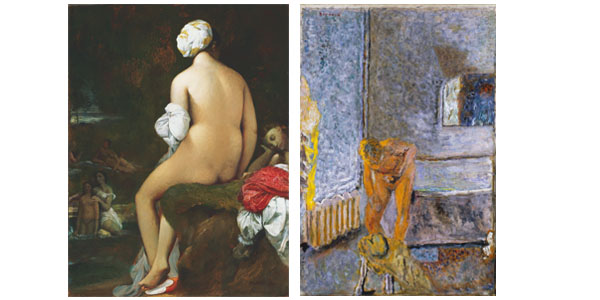Duncan Phillips once explained “I bring together congenial spirits among the artists from different parts of the world and from different periods of time.” Phillips’s curatorial philosophy is a hallmark of The Phillips Collection and gives visitors the opportunity to see artworks from different time periods, originating from different countries, created by different artists displayed together under one roof. Displaying artworks in this way allows visitors to discover new relationships between familiar artworks.

(left) Jean-Auguste-Dominique Ingres, The Small Bather, 1826. Oil on canvas, 12 7/8 x 9 7/8 in. The Phillips Collection, Washington, D.C. Acquired 1948.(right) Pierre Bonnard, Nude in an Interior, c. 1935. Oil on canvas, 28 3/4 x 19 3/4 in. The Phillips Collection, Washington, D.C. Acquired 1952.
Jean-Auguste-Dominique Ingres’s The Small Bather (1826) and Pierre Bonnard’s Nude in an Interior (c. 1935) provided such a point of departure for one of my recent tours of special exhibition Snapshot: Painters and Photography, Bonnard to Vuillard. As I did visitors on my tour, I invite you to consider the relationship between these two artworks, and ask yourself the following set of questions:
What do you see in each work of art?
What is the subject?
How would you describe the style of each painting?
Next, consider additional question:
What are some similarities and differences in both the style and subject of these two artworks?
And finally, ask yourself:
How might the invention of the camera inspire some of the differences between the two artworks?
I encourage you to share your observations in the comment section below. You can read some responses I received on my tour after the jump.
At the museum, these two artworks are currently on view in separate galleries. Small Bather is located on the 2nd floor by a staircase that leads up to the special exhibition on the 3rd floor, which includes Bonnard’s Nude in an Interior. I first walked my group to the 2nd floor gallery to study Ingres’ Small Bather. I began the tour with the question “what do you see?” I received a flurry of answers, concluding that the nude figure is the main subject, placed in the center of the painting and rendered in muted colors by a careful hand. As a group, we questioned whether the central figure is depicted realistically or idealized, wondered where the scene takes place, and discussed who the artwork is supposed to portray. I pointed out my favorite aspect of the painting–the luminous color and delicate detailing of the woman’s head wrap, which sparked more discussion about why the figure is rendered with significantly more detail than the background.
Next we made our way into the special exhibition to study Bonnard’s Nude in an Interior. Once again I asked “what do you see?” The group was quick to point out the heightened colors, loose brushwork, and unusual pose of the nude figure. The group considered Bonnard’s color choices, debated the meaning of the ill-defined objects in the background, and questioned the artist’s intent. One visitor noted the equal billing of “nude” and “interior” in the artwork’s title and observed that both subject and background are given the same amount of attention–unlike in Ingres’s painting. Another visitor added that perhaps this difference was due to the influence of the camera, which when used by an amateur photographer often captured both subject and background in equal detail. Bonnard’s ability to confuse subject and background through intense color and intricate patterning is something I admire in his work, and I found it enlightening that someone connected this trait to photography.
I challenged the group to think of additional ways in which the camera may have influenced Bonnard. The group speculated further that the random moments captured in Bonnard’s snapshots inspired him to replicate a seemly unplanned moment in paint. We noted that Nude in an Interior appears spontaneous because the figure is not posed but appears to be in motion and the edges of the painting appear cropped, cutting off some of the details. Another visitor suggested that the camera set Bonnard free from depicting reality as it is allowing him to use loose brushwork and exaggerated color.
As we considered these two works created over 100 years apart, I thought of Duncan Phillips and imagined that he would be pleased to see his vision of connecting ‘congenial spirits’ alive in the museum today.
Ellen Stedtefeld, Gallery Educator

The exhibit was a great platform to tie artists’ photos to their paintings. Thank you for pushing us to find other connections within the gallery.
Its true that the backgrounds of these paintings differ substantially. I did find that the pieces in the exhibit overall had very detailed and vibrant backgrounds. It was fun to see these when going theough the gallery as a whole.
Sounds like you enjoyed the exhibit. Finding connections between artworks is one of my favorite aspects of the Phillips.
I recently visited the Van Gogh museum in Amsterdam and I wish I’d had someone to ask the thought-provoking type of questions that you ask in this post and during your Phillips Collection tours.
Thanks Veronica! That is a great compliment!
What a delightful blog. You’ve not only illuminated the paintings in the collection, but the sophistication of visitors to the Phillips. Your questions provoked observations from your visitors that really helped me enjoy these paintings.
Thank you!
Thank you for the kind comment Jim. I am always impressed with the quality and thoughtfulness of the responses I receive on the tours as well.
Your thought provoking questions and observations always allow me to view the paintings in much more detail than I would if I just studied them on my own. I think Duncan Phillips would be happy with your connecting these two paintings. THANKS!